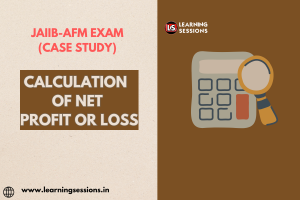The calculation of Net Profit or Net Loss is one of the core financial metrics that reveals the overall profitability of a business after accounting for all expenses, taxes, and non-operating incomes. For candidates preparing for the JAIIB exam, particularly the Accounting and Financial Management (AFM) module, understanding this concept is important. Understanding how net profit or loss is calculated can help future bankers and financial managers assess the viability of businesses, determine their financial health, and make informed lending decisions. Learning Sessions provides this article that presents a case study on calculating net profit or loss, explaining the formula and application in real-world banking and financial scenarios.

📚 JAIIB Study Resources 📚
👉 Check Here
👉 Check Here
👉 Check Here
👉 Get Tests Here
👉 Check Here
DOWNLOAD PDF CALCULATION OF NET PROFIT OR LOSS -CASE STUDY
Net profit or loss refers to the final figure that a business generates after deducting all operating expenses, interest, taxes, and non-operating costs from its total revenue. If the result is positive, it is termed Net Profit, and if negative, it is termed Net Loss.
For the extensive preparation of candidates, get details through our YouTube videos for JAIIB AFM Module wise Syllabus with explanations and tips to help candidates in their preparation journey.
You may also like these JAIIB case studies:
JAIIB | AFM | COMPUTERIZED ACCOUNTING
JAIIB | AFM | CORE BANKING SYSTEM
Net Profit Formula:
Net Profit = Total Revenue− (Operating Expenses + Interest + Taxes + Non-operating Costs)
In simple terms, net profit or loss is the amount left after accounting for all costs associated with running a business.
Furthermore, from a banking perspective, calculating net profit or loss is essential when evaluating a business’s financial strength. It helps banks determine whether a company is generating enough profits to cover its liabilities, pay back loans, and continue operations in the long run. It also provides insight into cash flow management, solvency, and liquidity—all key aspects of credit analysis.
The calculation of net profit or loss is a fundamental skill for JAIIB candidates studying the Accounting and Financial Management (AFM) module. Considering how to calculate and interpret net profit, future bankers can assess the financial health of businesses, make sound lending decisions, and contribute effectively to the financial management of their institutions. Learning Sessions provides additional information about JAIIB AFM ASSETS OF BANKING COMPANIES by giving examples of real life scenarios.
Learn more about this case study through our YouTube channel and PDF.
Get access to our Telegram Channel for free Pdfs of JAIIB.







